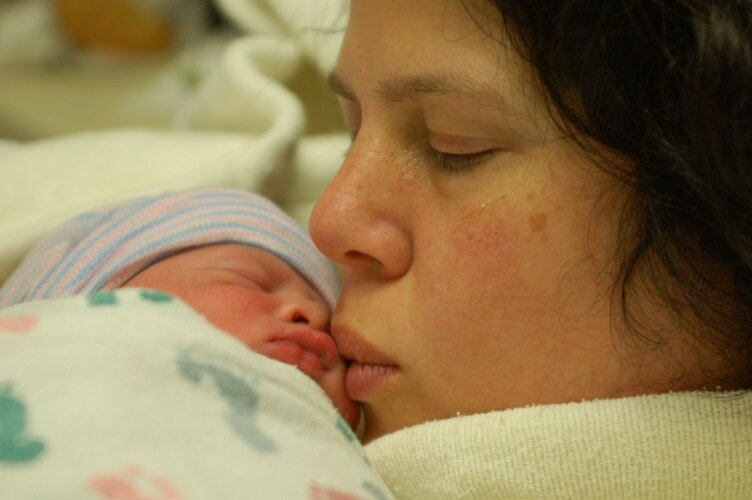Nurturing the Nurturer postpartum doula insights
Newborn sleep patterns: Are there any?
To the sleepless parent, newborn sleep might seem totally disorganised. For example, consider these points.
1. Newborns never sleep for long. Newborns sleep in short bouts — typically ranging from 30 minutes to 4 hours — at seemingly random times throughout the day and night.
2. Newborns awaken easily. In part, this is because they spend a large portion of their sleep time in “active sleep,” a light sleep state characterized by fluttering eyelids; rapid, irregular breathing; occasional body movements; and vocalizations (grunts or brief cries).
3. Newborn sleep times can vary widely. In the first few days, the average newborn sleeps between 16-18 hours a day (Iglowstein et al 2002). By four weeks, newborn sleep averages about 14 hours. But the range is considerable. Some four-week-old babies sleep as little as 9 out of 24 hours. Others sleep for 19 hours a day (Iglowstein et al 2002).
If your baby doesn’t fit the typical profile, does that mean something is wrong?
Not necessarily. Some babies suffer from medical conditions that influence the way they sleep, so if you have concerns you should discuss them with your medical provider. But it appears that many healthy, normal newborns deviate several hours from the average duration of sleep.
Newborn sleep rhythms: Why newborns seem to sleep—and wake—around the clock The timing of adult sleep is governed by circadian rhythms — physiological changes that follow a 24-hour cycle. Many of these changes are influenced by your exposure to light.
For instance, when you expose yourself to sunlight during the day, you are helping your body calibrate its internal clock. Even if you are sleep-deprived, morning light helps ensure that you will be more alert during the day than you are at night.
Conversely, the absence of light at night helps your body wind down. When darkness falls, your brain interprets this as a signal to start producing melatonin, a hormone that triggers relaxation, paving the way for sleep.
You can easily disrupt this process by exposing yourself to artificial light sources in the evening — especially sources of blue light (Wahnschaffe et al 2013). But as long as you stick with the program — bright light during the day, and darkness at night — you will likely find yourself in sync with the natural, 24-hour day.
And of course most adults are in sync. But it’s different for newborns.
Newborn sleep is not governed by strong circadian rhythms. Things don’t begin that way. Not when babies are still in the womb. During pregnancy, fetuses are tuned into their mothers’ physiological cues about day and night.
Fetal heart and respiratory rates speed up when a mother is active. They slow down when a mother is sleeping (Mirmiran et al 2003). Such changes may be influenced by maternal hormones, particularly melatonin. Maternal melatonin passes through the placenta, and may direct the fetus’ internal clock (Torres-Farfan et al 2006).
But after birth, this intimate hormonal connection is broken. Newborns must develop their own circadian rhythms of hormone production.
Unfortunately for us, this takes time (Kennaway 1996), and the process is complicated by the fact that newborns need to feed every few hours. As a result, newborn sleep episodes tend to be brief, and spaced at fairly regular intervals around the clock.
So when do babies develop mature circadian rhythms?
It’s normal for babies to take 12 weeks, or even longer. Most infants take about 12 weeks to show day-night rhythms in the production of melatonin (Rivkees 2003). Circadian changes in cortisol, a hormone that helps regulate alertness, may take even longer to emerge (Rivkees 2003). And, overall, babies may take 3-5 months before they “settle” at night–meaning that they sleep for more than 5 hours at a stretch (Jenni et al 2006; Pinilla and Birch 1993).
Nevertheless, newborn sleep isn’t completely divorced from the natural rhythms of the 24-hour day. Studies show that circadian rhythms begin developing in the first days after birth.
For example, German and Japanese studies have reported that newborns sleep more at night than they do during the day (Freudigman and Thoman 1998; Korte 2004; Matsuoka et al 1991).
And scientific evidence suggests that even newborns are receptive to environmental cues about time. You can take advantage of this fact to help shape newborn sleep patterns.
How to help newborns get in sync with the natural, 24-hour day
1. Make your baby a part of your daily routine. When parents include their newborns in their daily activities, newborn may adapt more rapidly to the 24-hour day (Custodio et al 2007; Lorh et al 1999). One study took continuous measurements of mother-infant activity patterns for four months after birth. Newborns who were active at the same time of day as their mothers were quicker to develop mature circadian rhythms (Wulff and Siegmund 2002).
2. Reduce stimulation at night. When your baby wakes for night time feedings, keep activity to a minimum. Make as little noise as possible, and avoid moving your baby around. Ideally, you want to avoid waking them “all the way up.” But if that isn’t possible, at least try to minimize the hustle and bustle. You want the baby to learn that nighttime is for sleep and quiet.
3. Expose your newborn to natural lighting patterns. Light cues might not instantly synchronize newborn sleep patterns, but they help.
For example, in one study, newborns slept longer at night if their parents observed a regular policy of turning out the lights by 9pm (Iwata et al 2017).
In another study, young babies tended to sleep longer at night if they had been exposed to lots of early afternoon light (Harrison 2004).
And time spent outdoors might make an important difference. Babies who go outside experience much higher daytime light levels than those kept indoors all day, and may develop stronger circadian rhythms as a result (Tsai et al 2012).
4. Try infant massage. A recent experiment found that mothers assigned to massage their newborns with lotion at bedtime experienced better newborn sleep outcomes than mothers who massaged without lotion and mothers in a control group who didn’t massage at all.
After one month, newborns massaged with lotion were falling asleep faster, staying asleep longer, and awakening at night less often. Mothers using lotion actually massaged their infants more frequently, which may explain the results (Field et al 2016). An earlier study found that infant massage helped newborns develop more mature patterns of melatonin secretion (Ferber 2002).
The takeaway? More research is needed on this topic (Bennett et al 2013), but meanwhile, this seems worth a try.
5. Do you pump and store breast milk? Consider keeping a record of what time of day you express. Breast milk contains tryptophan, an amino acid that is used by the body to manufacture melatonin. Tryptophan levels rise and fall according to maternal circadian rhythms, and when infants consume tryptophan before bedtime, they fall asleep faster (Steinberg et al 1992).
It’s therefore possible that breastfeeding helps newborn sleep patterns synchronize with the 24-hour day (Cubero et al 2005). This hypothesis was tested by feeding infants formula fortified with varying concentrations of tryptophan. When infants were given low levels of tryptophan during the day and high concentrations at night (mimicking the natural fluctuations of breast milk), infants fell asleep faster at night and got more sleep overall (Cubero et al 2007).
Newborn sleep cycles: Why newborns are light sleepers When adults first fall asleep, we pass through a couple of light sleep stages, and then plunge into a bout of deep sleep.
Afterwards, we switch into REM, or “rapid eye movement” sleep, a sleep stage famous for its association with dreaming, and the loss of muscle tone. We don’t move much during REM.
When REM is over, we either awaken, or return to light sleep and begin the cycle again. For the average adult, a single sleep cycle lasts about 90-100 minutes. We may partially awaken many times during the night. But we’re more likely to wake up “all the way” during transitions between stages, during light sleep, and during REM.
Newborn sleep is also characterized by sleep stages and cycles, but there are crucial differences. First, babies typically begin their sleep bouts in the newborn equivalent of REM (sometimes called “active sleep”).
Second, newborns in REM don’t usually experience muscle atonia.
Unlike us, they may thrash around, stretch, twitch, and even vocalize. The results can fool parents into thinking their babies are waking up, when they are actually experiencing normal REM sleep.
Third, newborn sleep cycles are shorter — around 50-55 minutes for the average infant — and REM makes up a much bigger proportion of sleep.
It’s not unusual for newborns to spend more than half their total sleep time in REM (Grigg-Damberger 2016). Indeed, several studies suggest that, over the course of a 24-hour day, some newborns may spend as much as 75% of their sleep time in active sleep (e.g., Poblano et al 2007; Sadeh et al 1996).
Fourth, while newborns do experience something roughly analogous to deep sleep, this stage, called “quiet sleep,” is potentially dangerous.
Characterized by slower, more rhythmic breathing, quiet sleep appears more restful (Grigg-Damberger 2016). But it’s harder for babies to awaken from quiet sleep, which can cause trouble if the baby isn’t getting enough oxygen.
This may explain why newborns don’t oblige exhausted parents by lapsing into long periods of deep sleep. It’s too risky. Instead, the typical 50-55 minute newborn sleep cycle includes only about 20 minutes of quiet sleep.
The rest of the time, babies are either in REM or in “transitional sleep,” a rather restless state that looks like a mash-up of active and quiet sleep, and which scientists don’t yet understand (Grigg-Damberget 2016).
Put this all together, and you can see why parents feel their babies are such light (and erratic) sleepers. Like adults, newborns are more likely to awaken during REM, and during transitions between sleep stages. But unlike adults, newborns spend a lot more time in REM, and they transition between cycles more frequently.
And parents may sometimes mistake REM restlessness for waking — and attempt to interact with or soothe a baby at the wrong time. In short, there are lots of opportunities for babies to wake up — or get awakened unnecessarily.
This sounds like a raw deal for parents. But newborns probably benefit from being light sleepers. Having a low threshold of arousal may protect babies from SIDS, and active sleep might be crucial for a newborn’s brain development (Heraghty et al 2008; Seigel 2005).
And if we understand the peculiar nature of newborn REM, we can learn to avoid jumping in too soon when we think a baby is awakening or signalling for us.
A baby who seems to be waking up may, if left alone, go back to sleep very rapidly.
How to keep your light sleeper from waking up all the way
1. Don’t rush in the moment you think your baby has awakened. As noted, babies experience frequent arousals, but that doesn’t mean they are doomed to wake up “all the way” every few minutes. Babies often jerk, sigh, or vocalize during partial arousals. If you avoid stimulating them during these moments, they may go back to sleep on their own.
2. Tank up the baby before you go to sleep. Whether you breastfeed or bottle-fed, try to give the baby an especially large meal before your own bedtime. This will encourage your baby to sleep longer. To learn more about this approach, see this Parenting Science guide to “Dream feeding.”
3. If you feed your baby formula, try to find one that includes DHA. DHA is a fatty acid found in fish oil and other dietary sources. It’s important for brain development, and may play a role in shaping sleep patterns as well.
In one study, children who consumed low levels of DHA had reduced amount of slow-wave (deep) sleep (Faglioli et al 1989).
In another study, pregnant women with higher blood levels of DHA gave birth to babies who spent more time in quiet sleep (Cheruku et al 2002).
DHA is found in breast milk, so it’s plausible (though unproven) that boosting a nursing mother’s DHA intake could improve a newborn’s sleep patterns. If you use formula, it seems like a good idea to find a baby formula that contains DHA.
4. Check out the article on baby sleep aids. There you’ll find tips for improving newborn sleep, and avoiding practices that are either unhelpful or potentially hazardous.
What about you? Tips for improving your own sleep
Newborn sleep patterns take their toll on parents. In a study tracking the sleep patterns of mothers from pregnancy through the postpartum period, maternal sleep worsened after childbirth and continued to deteriorate until about 12 weeks postpartum (Kang et al 2002)—the time when newborn sleep patterns begin to show marked circadian rhythms (Nishihara et al 2000).
Twelve weeks isn’t forever, but it can seem like it when you are severely sleep restricted. As you struggle to cope with newborn sleep patterns, don’t forget to look after yourself.
Here are some tips to help you cope.
1. Appreciate the power of a 30-minute nap When you’re running up an enormous sleep debt, you might think a 30-minute nap will make little difference to your health.
But recent research confirms that all naps are not the same. When you’re sleep deprived, the brain compensates by rendering naps more restorative than usual.
In one study, volunteers permitted to sleep only 2 hours at night showed the typical abnormalities in their stress hormone and immune factor chemistry. But after just two 30-minute naps, those irregularities were entirely normalized (Faraut et al 2015b).
In another study, volunteers coping with a 2-hour nightly regimen experienced heightened pain sensitivity — a common symptom of sleep deprivation. But once again, the effect was reversed after just two 30-minute naps (Faraut et al 2015a).
2. Don’t assume that it’s pointless to lie down if you don’t fall asleep. You might pass into a state of drowsy, semi-conscious sleep — and reap some benefits.
Too wired to “sleep when the baby sleeps”? If so, keep in mind that quiet resting is better than nothing. In fact, if you are lying down with your eyes closed, you might be asleep without realizing it.
In numerous lab studies, subjects who were awakened from the first stage of sleep often denied that they were asleep at all (Dement and Vaughan 1999). A nap that consists only of stage 1 sleep might not help you improve your reaction times, but it will probably make you feel less tired. And if you manage to slip into the second stage of sleep — even for just 3 minutes — your nap may have recuperative effects (Hayashi et al 2005).
3. Don’t play the blame game. Brooding about the situation will make it harder for you to fall asleep when you are given the opportunity. And it’s wrong-headed, too: You might be doing everything you can to get more sleep, and still be stuck with a baby who sleeps less than average.
Research suggests that the amount of sleep we get at night is strongly influenced by genetics (Touchette et al 2013), and, as mentioned above, there is a lot of individual variation among newborns.
4. Don’t assume that breastfeeding will make you more sleepless than formula feeding. One study reported that the parents of breastfed babies averaged 40-45 minutes more sleep time than did the parents of formula-fed babies (Doan et al 2007).
5. If you are breastfeeding, you are likely to get more sleep if you keep your baby nearby. The World Health Organization recommends that babies share a bedroom with their parents, and it’s a recommendation that makes breastfeeding less disruptive. A recent study found that breastfeeding women got more sleep when they co-slept, same room, with baby (Quillin and Glenn 2004). In fact, mothers who co-slept, same room, and breastfed got more sleep than did mothers who bottle-fed their babies (Quillin and Glenn 2004).
6. If your baby is asleep, don’t worry about changing diapers. If your baby can’t sleep because they need a diaper change, they’ll let you know. And a little urine is unlikely to awaken them anyway. In a recent experiment, researchers injected water into the diapers of sleeping infants to see if this would wake them up (Zotter et al 2007). It didn’t.
7. Get sunlight and avoid artificial lighting at night. Make sure you expose yourself and your baby to bright light during the day. And keep lights out–or at least dimmed–after sunset.
As noted above, natural lighting helps influence newborn sleep patterns. But it also helps you keep your own circadian rhythms from drifting, which is important if you are going avoid insomnia and be a source of daytime cues for your newborn.
8. Let a friend or family member watch your baby while you take a nap, even if this means your breastfed baby will take some meals from a bottle. Lactation experts often discourage breastfeeding mothers from bottle feeding babies for the first 3-4 weeks. The worry is that supplemental feeds will lead to a decreased milk supply and endanger successful breastfeeding in the long-term.
But you need to balance this against the negative effects of severe sleep restriction. Lack of sleep puts parents at increased risk of illness and postpartum depression, which is bad for parents and babies. If you are at the end of your rope, get help.
9. Trust your instincts, and get help when you feel stressed If something feels wrong with you or the baby, talk to your physician. And remember that your own mental health is crucial.
Coping with sleep deprivation is very stressful, especially if your infant seems to be especially fussy or prone to crying. Watch for signs of postpartum stress and postpartum depression, and reach out to others for support.
10. Remember that things will get better Newborns have special sleep patterns and special needs. But things will start to get better around 12 weeks postpartum.
More reading relevant to newborn sleep
For more information about babies and sleep, see these fully-referenced Parenting Science articles.
References: What scientific studies say about newborn sleep




















